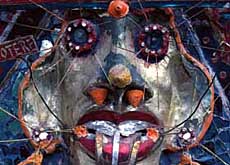The fantasy world of Podestà in two Swiss cities

Two exhibitions of works by one of the 20th century’s most remarkable “outsider” artists have opened at separate venues in Switzerland.
Both raise intriguing questions about the art form and its creators, many of who did not see themselves as artists.
One is a major retrospective in a Lausanne museum housing the world’s finest permanent collection of “art brut”, known in English as outsider art, while the other is in Fribourg’s Espace Jean Tinguely-Niki de Saint Phalle.
A typical outsider artist is someone institutionalised who finds it difficult to live in society – a loner or outcast with no formal training who creates an imaginary world.
Giovanni Battista Podestà (1895-1976) fits the outsider artist profile, even though he was neither a loner nor institutionalised.
“He wasn’t an artist, writer or philosopher as such,” says Lucienne Peiry, director of the art brut collection in Lausanne. “He had no cultural training at all.”
Scarred soldier
Yet even a casual glance at the multi-coloured sculptures, ceramics and other works created by Podestà reveals that he was a self-taught artist of the highest order.
His family background in a northern Italian village was one of poverty. He left school at the age of ten after his father’s death, and was forced to work to help support his mother and 12 sisters.
Later, he was mentally scarred by his experiences as a soldier during World War I, and for the rest of his life devoted himself to art in a small apartment in the town of Laveno.
Utopian universe
“Podestà created a Utopian universe,” Peiry told swissinfo. “[It was made] from discarded materials such as silver wrapping paper, plaster and glue which he made into ceramics, sculptures and even furniture and clothing.
“He left his joyful mark on many objects in an expression of protest against what he saw as the loss of spiritual and symbolic values in a materialistic society.”
Undoubtedly eccentric, Podestà never lived a life of silence and solitude.
In fact his appearance – long hair and a flowing beard – attracted attention during his daily walks and brought him into contact with people fascinated by a man wearing clothes he had created, including a necktie on which he had painted a skeleton.
Over 60 of his creations are on view at the Art Brut museum in Lausanne until January 25.
The Fribourg exhibition, which also ends in January, consists of art works collected by one of his greatest fans, Jean Tinguely, who like Podestà, was a sculptor who used discarded materials found on rubbish heaps and in trash cans.
swissinfo, Richard Dawson
Giovanni Battista Podestà (1895-1976) left school at ten after the death of his father, and worked to support his mother and 12 sisters.
He never recovered from his experiences as a soldier during World War I.
A self-taught “outsider” artist, Podestà created multi-coloured sculptures and ceramics from discarded materials as well as furniture and clothing.
Swiss kinetic sculptor Jean Tinguely, who used similar materials, built up a substantial private collection of his works.

In compliance with the JTI standards
More: SWI swissinfo.ch certified by the Journalism Trust Initiative
You can find an overview of ongoing debates with our journalists here . Please join us!
If you want to start a conversation about a topic raised in this article or want to report factual errors, email us at english@swissinfo.ch.